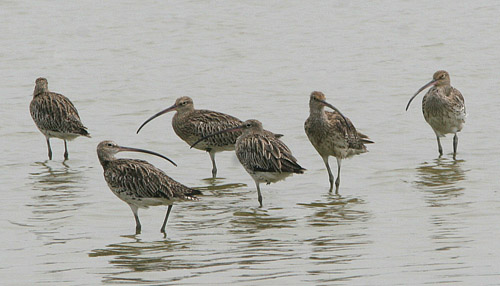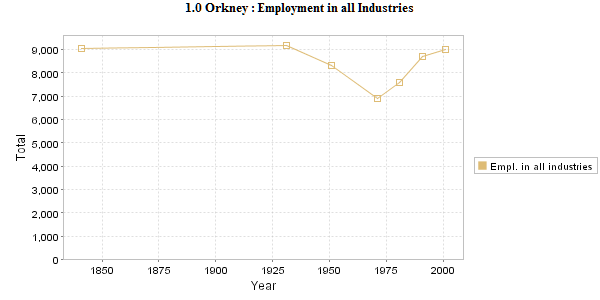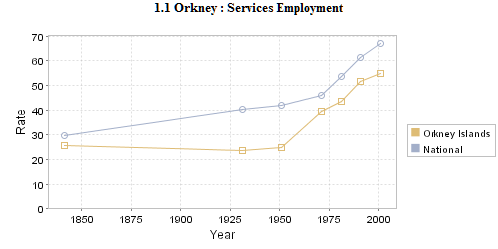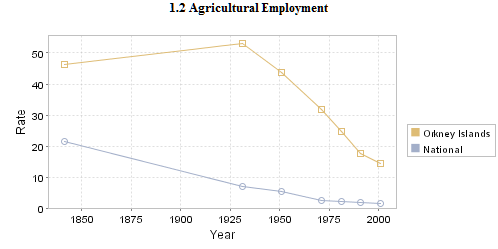|
|
|
|
|
|
|
||||||
|
|
||||||
|
|
Orkney IndustryThe council recently produced an economic review document which is available as a PDF document from the official OIC website. As it is a little hard to find you can also download it here if you wish.Economic Review
The main industries in Orkney are farming, in particular beef farming, the oil terminal at Flotta, and more recently, Tourism which is now the biggest sector of the local economy. Of a total area of 400 sq. miles, 300 sq. miles are farmed. The complexities of the EC CAP are beyond casual understanding but suffice to say subsidies are a major crop. Fishing is now all but defunct, with Creels and some whitefish boats a remnant industry.The largest employers are Orkney Islands Council and Orkney Health Board (NHS). Amazingly these two bodies employ over 2500 people, so one in eight people here is paid to look after the other seven. One of the positive results of this is an educational infrastructure and system second to none, the lowest crime rate in the UK and up until recently a first class National Health Service. Sadly it seems our NHS has now been infected by the disease of under resourcing like everywhere in the UK. One of the less obvious negative results of this booming service sector is the existence of a bi-polar employment economy. If you work for the OIC or the NHS you will be paid at national rates. If you work outside then pay levels are very low, probably less than half the UK average. Additionally, many of the admin jobs available in the service sector are most likely to be filled by external applicants. It is just a guess but I would think that by now at least two thirds of admin and three quarters of management jobs are filled by non-native incomers. We also have road surfaces without blemish, a minor detail that is only appreciated when you drive on the third world surfaces of London. Manufacturing as an industry in Orkney is relatively small, depending on food products, distilling and arts/crafts goods such as textiles, jewelry, paintings and pottery. The general standard of all these operations is extremely high. Orkney Beef is some of the best in Scotland which means the World. Orkney Beer is world class award winning ale. Orkney Ice Cream is nationally award winning. The Jewelry makers are world famous, Highland park malt wins international acclaim everywhere. Local entrepreneurship is somewhat stunted due to the huge service sector and subsidy culture, but two men have broken the mould recently, Neil Stevenson, proprietor of Grooves Records and founder of Fusion Night-club and Andrew Banks, owner of Pentland Ferries. EmploymentInformation in this section is sourced from the UK Census data collated over the past 150 years. Obviously certain definitions change over time but this is the best source available. Currently registered unemployment in Orkney is very low, around 1.5%, less than half the Scottish average and one of the lowest rates in the UK. Graphical representations used in this section are copyright Visions of Britain.
Fig 1.0 shows all employment in Orkney since the 1840 Census. Two factors stand out. Firstly the remarkable consistency, with around 9000 economically active citizens in 1840 and 9600 in 2001. Secondly, the marked decline caused by the collapse in agricultural employment and subsequent fall in total population during the mid section of the 20th century, with the low point (7200) being reached in 1971. The rapid climb since that date started with the Oil Terminal at Flotta and continues today with the booming Tourism and Construction sectors leading the way. Looking within the figures is also illuminating. For those of working age Male employment has stayed within similar parameters, with around 5000 active and 1400 inactive throughout the period. The female figures are inverted, with 4300 inactive in 1971 becoming 4200 active in 2001, and 2300 active in 1971 becoming 2600 inactive in 2001. The increase in employment over the past 30 years seems at least superficially, to have been almost entirely represented by more active Women in the economy. This trend is of course Nation-wide.
Fig 1.1 looks at the service sector, which both Nationally and within Orkney has for some time been the largest part of the economy. The consistently lower representation by Orkney is common to most Rural areas, but the rate of increase here is faster than the National average, implying that we will catch up before long. Translating these percentages to real figures, of the 9600 active people in the 2001 census 1800 work for the council and 600 work for the NHS. This is 23% of the entire working population, and is the core of the two tier economy within Orkney. Additional to this are further state jobs in DHSS, Dept of Agriculture, Fisheries, Environment etcetera, which probably takes this figure well beyond 30% of all employment. The remaining 25% service sector jobs would be almost all low level minimum wage retail, tourism and hotel type employment.
Moving away from the service sector it would be fair to assume that farming would represent an important share of employment in Orkney (Fig 1.2). This certainly used to be the case, with over 50% of all jobs being in Agriculture well into the mid 20th century. The rapid decline post 2nd World War coincided with the collapse in overall population and clearly shows the devastating effect of mechanization and new technology on Farming as a source of work. Today according to census information less than 15% of the jobs in Orkney are in farming. Fewer jobs doesn’t mean less money or influence. Recent Publication of the single farm payment subsidies for Orkney showed that in excess of £11 million per annum is received in EC subsidy by the Farmers here. This is shared between 30,000 beef cattle, 60,000 sheep and 1900 farm holdings. The farming sector is somewhat complex. According to detailed figures produced as part of the SEERAD agicultural census farming generates 2100 jobs, closer to 25% of the total rather than the 15% according to the UK census. This is probably explained by the numbers involved as small holders. More than 1500 of these “jobs,” are held by part time crofters, Husband and Wife farmers and single stedding occupiers. Less than 300 actual full time PAYE jobs exist in the farming sector, with a further 200 part time or seasonal jobs. Almost all of these jobs would be as farm laborers on minimum wage and long hours. It should also be remembered that crofters have entirely separate sources of financial subsidies. Small holdings and crofting cannot in all fairness be described as jobs in the conventional sense. Either through inheritance, choice or circumstance they are lifestyles. What does this leave ? Around 70% are in services and farming. Of this figure the majority would be in low paid private sector jobs, minimum wage up to maybe £10/hour. Of the total remaining 30%, these would be made up mainly by Construction which is booming in Orkney, 350 self-employed creel fishermen, 100 commercial fish farmers, sole tradesmen, craftsmen and Artists. A small but significant percentage of jobs would be found in Jewellery probably the biggest manufacturing industry in Orkney. One growing area is of course energy renewables and environmental consultancy which is a new source of well paid private sector employment. If you set aside public services sector employment, which are paid at National equivalent rates, then Wages are low and good jobs rare. Of course, in reality you cannot ignore this state employed 30%. They in fact drive the economy, with relatively high rates of disposable income supporting many private sector operations as a direct result. The logic of the state feeding the people somewhat escapes my naturally libertarian principles but it appears to work, as long as you don’t over scrutinise. Recent anecdotal surveys show this to be the case. Men in Orkney work the longest hours in Britain, seven hours a week more than their counterparts in Edinburgh and over eight hours more than Londoners, according to figures revealed in a recent survey by the GMB union which found full-time workers in Orkney put in an average shift of 45.8 hours per week, while the average UK male works 40.6 hours. Further, Orkney has one of the lowest rates of pay for workers in Scotland, coming above only Dundee and Moray. The figures, released by the Bank of Scotland, show that Orkney has an average full-time gross weekly pay of £414, slightly higher than Dundee, on £401, and Moray, on £389. This is in contrast with the highest paid area, Stirling, with a weekly average of £563.50. Personally I have no doubt that if a comprehensive study of the private sector in Orkney was undertaken then these figures would be even more extreme. Most self-employed people I know have no concept of a 40-50 hour week. |
|
|




